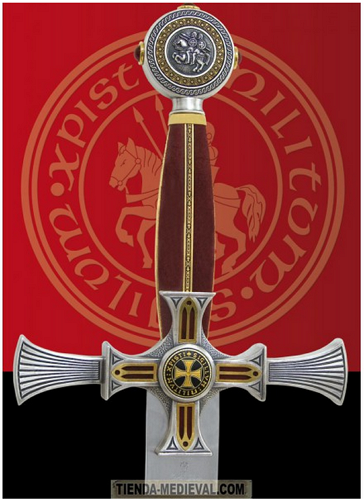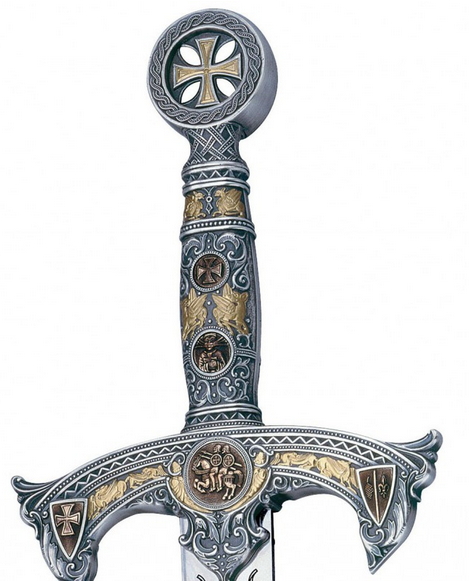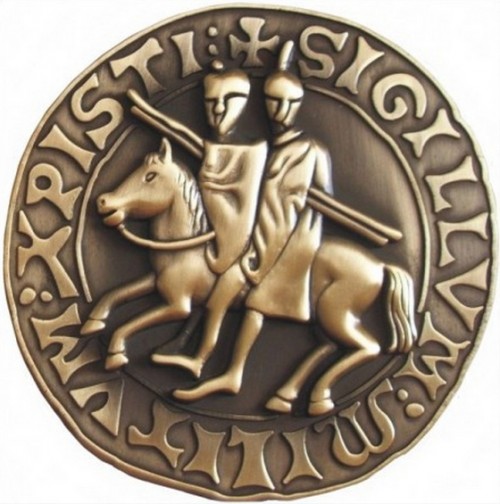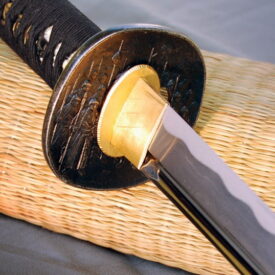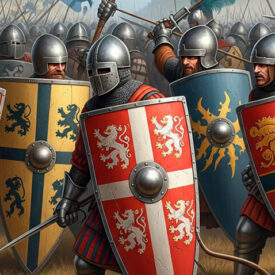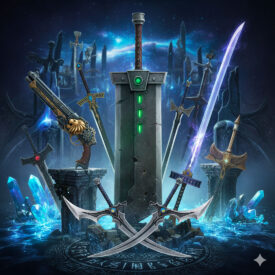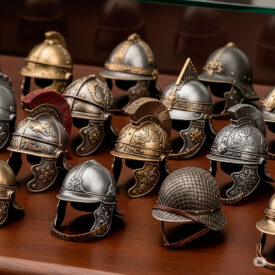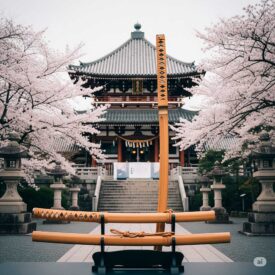Templar swords evoke images of honor, faith, and legendary battles. For the Knights of the Order of the Temple, this was not merely a weapon, but a profound symbol of their vows, their mission, and their very identity. In this detailed article, we will explore what these swords were like, what they symbolized, how they were used, and why they continue to fascinate historians, collectors, and medieval history enthusiasts today.
The Order of the Temple: monks and warriors
The Order of the Poor Knights of Christ and of the Temple of Solomon, better known as the Order of the Temple, was founded around 1118 by Hugh de Payns and seven other French knights. Their original mission was to protect pilgrims traveling to the Holy Land, but their role soon expanded to active combat in the Crusades and, in the Iberian Peninsula, in the Reconquista.
During the 12th and 13th centuries, the Templars, along with orders such as the Hospitallers and the Calatrava, formed an autonomous and professional army. The generous donations from Christendom provided them with enormous economic and territorial power, transforming them into a political and military entity of great influence in Europe.
By the mid-13th century, the Templars’ fame was legendary for their discipline and success on the battlefield, but their prosperity also generated envy and suspicion. In 1307, King Philip IV of France, plagued by debts and ambitions, initiated a campaign that led to the mass arrest, trial, and eventual dissolution of the Order in 1312, with the consequent confiscation of assets.
What the Templar sword was like: shape and typology
A Templar’s sword was not usually an ostentatious object: its design obeyed a practical purpose and a vow of austerity. Each brother received standard equipment in the commandery that included, among other elements, the sword, helmet, hauberk, and dagger.
Templar swords were versatile weapons designed for both mounted and foot combat. The pommel sword predominated, double-edged and with a relatively straight blade provided with a wide fuller to lighten and strengthen the structure.
According to Oakeshott’s classic typology, many of these pieces would fit into types X, Xa, or XI, with variations in length and weight depending on the intended use. Some swords were designed for blunt strikes and others for precise thrusts. Although longer blades designed for two-handed grips appeared at the end of the 12th century, Templar practice preferred lighter blades for mounted combat and shorter, heavier blade pieces for close-quarters foot combat.
A typical equipment received by a Templar included:
- Pommel sword (main weapon).
- Long spear for charging from horseback.
- Mace or axe to break mail and shields.
- Dagger for close combat and as a tool.
- Shield and armor (hauberk, helmet, iron breeches).
The weight of a Templar sword could vary widely; “mandobles” or heavy impact weapons reached almost 1.5 kg, while finer and longer cavalry blades were lighter and more maneuverable.
Hilt, pommel, and guard: austerity with symbols
Direct records of the exact design of Templar hilts are limited, but archaeological evidence and iconographic representations allow us to infer some constants. The hilt tended to be simple, with discoidal or rounded pommels that facilitated blade balance and added no unnecessary ornamentation.
The guard, also called quillons, could be straight or somewhat spatulate, a shape consistent with the cross that identified the Order. In many representations, the cross pattée appears on cloaks, shields, and accessories, and sometimes engraved or represented on the swords themselves.
The hidden symbology in the blade
For the Templars, the sword was more than an instrument of war: it was an icon of authority, spiritual purity, and duty. The blade was associated with light, fire, and purification; it was often used as a metaphor for the battle against ignorance and injustice.
It is common to find inscriptions on replicas and some historical pieces with religious mottos. The most famous, “Non nobis, Domine, non nobis, Sed Nomini Tuo Da Gloriam,” recalls that glory should go to the name of God and not to the warrior. This mentality underscored the spiritual vocation of the Order despite its military nature.
The Templar cross, especially the red cross pattée on a white background, was the most recognizable visual emblem. It was used on cloaks, banners, and sometimes on hilts and pommels. The cross represented Christ’s martyrdom and the willingness to sacrifice one’s life for faith.
The Templar seal and the symbolic message
The Templar seal, with two knights riding a single horse, is one of the most iconic images associated with the Order. It represented the initial poverty of the founders and, at the same time, a deeper idea about duality: monks and warriors, body and spirit, coexistence of cultures in the Holy Land.
The Latin inscription, “Sigillum Militum Xpisti” (The Seal of the Soldiers of Christ), reinforced both the martial and spiritual identity. For a Templar, carrying a sword with symbols was a reminder of the ultimate reason for their mission and the ethical limits they had to observe.
Tempering: technique and metaphor
The metallurgical process of tempering not only affected the strength and flexibility of the blade, but also acquired an initiatic meaning within the Templar imaginary. Tempering a sword came to be understood as a parallel to the inner tempering of the knight: strength, clarity, and self-control.
From a practical point of view, tempering consisted of heating the blade to a certain temperature and then rapidly cooling it, which modified the properties of the steel. The objective was to achieve an optimal combination of hardness and toughness, preventing the blade from breaking in combat.
In symbolic tradition, the “tempered” sword represented an initiate who had been tested and purified, prepared to fulfill their duty without succumbing to ambition or anger.
Templar Swords in Combat: Tactics and Use
On the battlefield, the Templars deployed combined tactics. In a cavalry charge, the spear was the primary weapon, but the sword played a central role in close combat and on-foot assaults. The versatility of the Templar sword made it an essential element of the knight’s arsenal.
When fighting on foot, Templars supplemented the sword with a dagger and a mace. Medieval fencing techniques combined cuts, thrusts, and pushing blows with the hilt to unbalance the opponent. The Order’s martial discipline and continuous training made each brother an effective combatant in both defense and offense.
How to identify an authentic Templar sword
Determining whether a sword is authentic and related to the Order of the Temple requires a set of evidence. Among the criteria to consider are:
- Archaeological context: findings associated with medieval sites or documented burials.
- Blade typology: correspondence with the shapes and measurements of the period (X–XI according to Oakeshott).
- Engravings and inscriptions: presence of mottos, crosses, or seals that can be dated with historical and scientific methods.
- Metallurgical analysis: steel composition, forging techniques, and tempering patterns compatible with the Middle Ages.
If you are looking for a replica or a collector’s item, in our online store we offer faithful reproductions of historical models, with different finishes and qualities depending on the intended use: decorative, reenactment or practice.
Conservation and care of a Templar sword (replica or historical)
A sword, whether replica or historical, requires basic care to maintain its condition. Preventing rust, cleaning after use, and storing it in dry conditions are essential to preserve the metal and engravings.
Practical recommendations:
- Clean the blade with oil and a soft cloth after handling.
- Avoid prolonged contact with moisture and saline environments.
- Use sheaths or stands that allow air circulation.
- Line the hilt with suitable materials to prevent corrosion from sweat.
Replicas and collecting: differences and buying tips
Commercial replicas of Templar swords vary from clearly decorative pieces to functional reproductions suitable for practice and historical reenactment. Before buying, it is advisable to ask what the main use will be: display, light handling, reenactment, or cutting.
Points to consider when acquiring a replica:
- Type of steel and its heat treatment.
- Quality of assembly (tang, pommel and guard assembly).
- Finish and engravings faithful to historical models if authenticity is sought.
If you are looking for where to buy, you can do so in our online store, where we offer different ranges and advice to choose the Templar sword that best suits your needs.
The legacy of Templar swords today
The image of the Templar sword continues to fuel popular culture, literature, cinema, and historical reenactment. Beyond romanticism, these weapons refer to a complex historical reality: religious military orders with strict rules, political tensions, and a relevant role in the configuration of medieval Europe.
Today, swords preserved in museums or quality replicas serve as a bridge between the past and the present. They allow us to understand technical aspects of medieval metallurgy, as well as to reflect on values such as discipline, faith, and the contradictions of power.

